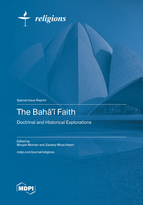The Bahā'ī Faith: Doctrinal and Historical Explorations
A special issue of Religions (ISSN 2077-1444). This special issue belongs to the section "Religions and Theologies".
Deadline for manuscript submissions: closed (1 February 2023) | Viewed by 19827
Special Issue Editors
Interests: Bahā’ī history; Shi`i Islam; Qajar Iran; the study of religion
Special Issue Information
Dear Colleagues,
The Bahā’ī Faith has been in existence for over 160 years and in that time has spread around the world such that there are now organized Bahā’ī communities in almost every country of the world and, according to the statistics compiled by the Association of Religion Data Archives, over 7 million Bahā’īs.1 All such statistics can be problematized but what is undoubted is that the Bahā’ī Faith has not received from the academic community the amount of attention and research that its size and rapid growth would warrant. Until recently, there have been only a handful of scholars in North America and Europe and almost none in the rest of the world who have had this religion as the main focus of their research and very few papers and monographs were published in the past one hundred years or so. The situation is improving gradually but only slowly so.
The collection of papers in this Special Issue is a small effort toward correcting this deficit in the publications available to the academic world. The theme has been made deliberately broad so that the scholars who contribute can present the research they are currently engaged in.
Note
- https://www.thearda.com/QL2010/QuickList_125.asp (accessed 26 May 2022)
©2001 World Christian Trends, William Carey Library, David Barrett & Todd Johnson
Tentative Completion Schedule
- Abstract submission deadline: 1 January 2022
- Notification of abstract acceptance: 15 January 2022
- Full manuscript deadline: 30 December 2022
Dr. Moojan Momen
Dr. Zackery Mirza Heern
Guest Editors
Manuscript Submission Information
Manuscripts should be submitted online at www.mdpi.com by registering and logging in to this website. Once you are registered, click here to go to the submission form. Manuscripts can be submitted until the deadline. All submissions that pass pre-check are peer-reviewed. Accepted papers will be published continuously in the journal (as soon as accepted) and will be listed together on the special issue website. Research articles, review articles as well as short communications are invited. For planned papers, a title and short abstract (about 100 words) can be sent to the Editorial Office for announcement on this website.
Submitted manuscripts should not have been published previously, nor be under consideration for publication elsewhere (except conference proceedings papers). All manuscripts are thoroughly refereed through a double-blind peer-review process. A guide for authors and other relevant information for submission of manuscripts is available on the Instructions for Authors page. Religions is an international peer-reviewed open access monthly journal published by MDPI.
Please visit the Instructions for Authors page before submitting a manuscript. The Article Processing Charge (APC) for publication in this open access journal is 1800 CHF (Swiss Francs). Submitted papers should be well formatted and use good English. Authors may use MDPI's English editing service prior to publication or during author revisions.
Keywords
- Baha'i
- Baha'i history
- Baha'i textual studies
- Baha'i doctrinal studies
- Babi movement
- Bahai







